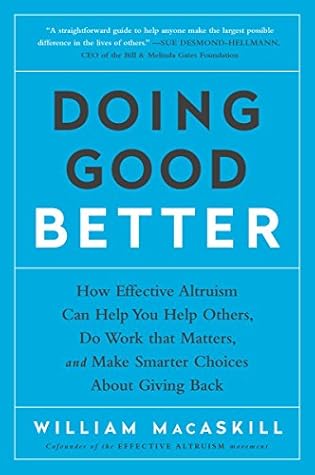More on this book
Community
Kindle Notes & Highlights
Read between
November 28 - December 9, 2020
Effective altruism is about asking, “How can I make the biggest difference I can?” and using evidence and careful reasoning to try to find an answer. It takes a scientific approach to doing good.
Many people believe that altruism should denote sacrifice, but if you can do good while maintaining a comfortable life for yourself, that’s a bonus, and I’m very happy to call that altruism.
How many people benefit, and by how much? Is this the most effective thing you can do? Is this area neglected? What would have happened otherwise? What are the chances of success, and how good would success be?
If you earn more than $52,000 per year, then, speaking globally, you are the 1 percent.
thinking in terms of improving lives rather than in terms of intermediate metrics like number of schoolbooks provided.
We’re used to thinking of what’s typical and what’s average as being the same.
Funding seems to be allocated in proportion with how evocative and widely publicized the disaster is, rather than on the basis of its scale and severity.
Again, we see the 100x Multiplier at work. We’re about one hundred times richer than the poorest billion people in the world, and we can do several hundred times more to help them than we can to help others in the rich countries we live in.
Earning to give means exactly what it sounds like: rather than trying to maximize the direct impact you have with your job, you instead try to increase your earnings so you can donate more, improving people’s lives through your giving rather than your day-to-day work.
Thinking explicitly about expected value is important because humans are often terrible at assessing low-probability high-value events. Psychologists have found that people either give too much weight to low-probability events (as, perhaps, when people choose to play the lottery), or they simply ignore them all together.
In developing countries, sweatshop jobs are the good jobs. The alternatives are typically worse, such as backbreaking, low-paid farm labor, scavenging, or unemployment.
Because sweatshops are good for poor countries, if we boycott them we make people in poor countries worse off.
Fairtrade certification is an attempt to give higher pay to workers in poor countries. It’s commonly used for consumables grown in developing countries, such as bananas, chocolate, coffee, sugar, and tea.
Given this, there is little reason to buy Fairtrade products. In buying Fairtrade products, you’re at best giving very small amounts of money to people in comparatively well-off countries. You’d do considerably more good by buying cheaper goods and donating the money you save to one of the cost-effective charities mentioned in the previous chapter.
ethical consumerism
Using this figure, the average American adult would have to spend $105 per year in order to offset all their carbon emissions. This is significant, but to most people it’s considerably less than it would cost to make large changes in lifestyle, such as not flying. This suggests that the easiest and most effective way to cut down your carbon footprint is simply to donate to Cool Earth.


